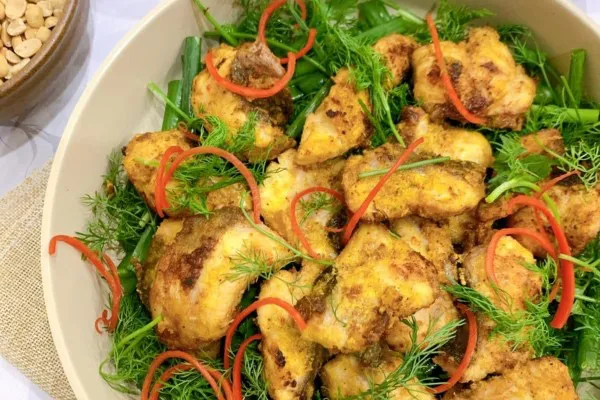Hanoi cuisine is not just about food; it is about preserving and passing down cultural and historical stories through generations. Alongside pho, bun cha, and com Vong, the specialty of Cha Ca La Vong in Hanoi offers a unique flavor that embodies the essence of the capital city, leaving diners with unforgettable memories.
Cha Ca La Vong is more than a delicious dish; it symbolizes the intricate and sophisticated culinary art of Hanoi. Let’s explore this extraordinary dish, from its meticulous preparation to the secrets of fully savoring its unforgettable taste.
Cha Ca La Vong: More Than Just a Dish
Cha Ca La Vong is an age-old Hanoi specialty, famous for its distinctive and inimitable flavor. This dish is made from fresh fish, usually marble goby, snakehead, or red snapper, cut into bite-sized pieces and carefully marinated with galangal, fermented rice, turmeric, and secret spices.

To create the famous Cha Ca La Vong, chefs must undergo several meticulous stages. The fish, after marinating, is lightly grilled over charcoal until partially cooked and then fried again in hot oil. It is served on a sizzling pan and eaten with vermicelli, fresh herbs, roasted peanuts, and shrimp paste – the soul of this dish.
The Origins and Story Behind Cha Ca La Vong
Few people know that Cha Ca La Vong originated from the Doan family at 14 Hang Son Street (now Cha Ca Street) during the French colonial period. Initially, it was made from a rare fish called Anh Vu, found only in the confluence of the Bach Hac River (Phu Tho). However, as the Anh Vu became scarcer, other types of fish like marble goby and snakehead were used instead.
The name “Cha Ca La Vong” is associated with an interesting story. During the French colonial period, the Doan family regularly aided a poor old man. In gratitude, he taught them the special recipe for Cha Ca. Later, when they opened a restaurant, they named it “Cha Ca La Vong” after a legendary character, hoping their eatery would always be cherished by diners.
In 2003, Cha Ca La Vong Restaurant in Hanoi gained international acclaim when author Patricia Schultz included it in her book “1,000 Places to See Before You Die”, confirming the dish’s status on the global culinary map.
Secrets to Making Authentic Hanoi’s Cha Ca La Vong
To prepare Cha Ca La Vong at home, gather the following ingredients:
-
Ingredients:
- 500g marble goby fillet (or snakehead, red snapper)
- Dill, spring onions
- 40g finely crushed galangal
- 500g fresh vermicelli
- 50g roasted peanuts
- 2 chili peppers
- 4 kumquats (or limes)
- 2 shallots
- 2 lemongrass stalks
- 1 turmeric root
- Cooking oil
- Seasonings: shrimp paste, fermented rice, salt, ground pepper, sugar, turmeric powder
-
Preparation Steps:
- Prepping: Clean the fish, cut into appropriate pieces. Wash dill and spring onions, cut into small sections. Mince lemongrass and shallots. Peel and blend turmeric.
Ingredients for making Cha Ca La Vong
- Marinating: Marinate fish with minced shallots, crushed galangal, minced lemongrass, blended turmeric, along with salt, pepper, sugar, fermented rice, shrimp paste, and turmeric powder. Mix well and let marinate for about 2 hours.
How to marinate Cha Ca La Vong
- Grilling: Wrap a baking tray in foil, arrange fish, and grill at 180 degrees Celsius for about 10-15 minutes. Alternatively, grill over charcoal for better aroma.
How to marinate Cha Ca La Vong
- Shrimp Paste Preparation: Mix shrimp paste, sugar, kumquat juice, and sliced chilies in a bowl. Stir until the sugar dissolves completely.
How to prepare shrimp paste for Cha Ca La Vong
- Frying and Serving: Heat a pan with cooking oil, then fry the grilled fish until golden brown. Quickly add spring onions and dill. Remove the fish and serve with vermicelli, shrimp paste, and roasted peanuts.
How to make Cha Ca La Vong with marble goby and present the dish on the stove
Enjoying Cha Ca La Vong the Right Way
Cha Ca La Vong is best enjoyed hot. Take a piece of golden, fragrant Cha Ca, add some vermicelli, fresh herbs, drizzle with rich shrimp paste, and sprinkle some crunchy roasted peanuts. This combination creates a unique, unforgettable flavor.

To enhance the dish’s flavor, you can squeeze some kumquat (lime) juice into the shrimp paste or serve it with fresh chilies. Cha Ca La Vong is not just a delicious dish; it’s a delightful culinary experience that lets you appreciate the intricacy and sophistication of Hanoi’s gastronomic culture.
Recommended Places to Enjoy Famous Cha Ca La Vong in Hanoi
If you wish to savor authentic Cha Ca La Vong in Hanoi, visit the following spots:
- Cha Ca La Vong (14 Cha Ca): The oldest eatery, the birthplace of the famous Cha Ca La Vong.
- Cha Ca Anh Vu: Another renowned spot for its rich, aromatic Cha Ca.
- Cha Ca Thang Long: A popular venue known for its spacious, airy atmosphere.
Additionally, you can find Cha Ca La Vong at many other restaurants and eateries throughout Hanoi’s streets.
Conclusion
Hanoi’s Cha Ca La Vong specialty is more than just a dish; it’s a part of the city’s culture and history. With its unique flavors, meticulous preparation, and intriguing backstory, Cha Ca La Vong is undoubtedly a must-try when visiting the capital. Indulge in it to truly experience the culinary essence of this historic city.
 Ingredients for making Cha Ca La Vong
Ingredients for making Cha Ca La Vong How to marinate Cha Ca La Vong
How to marinate Cha Ca La Vong How to prepare shrimp paste for Cha Ca La Vong
How to prepare shrimp paste for Cha Ca La Vong